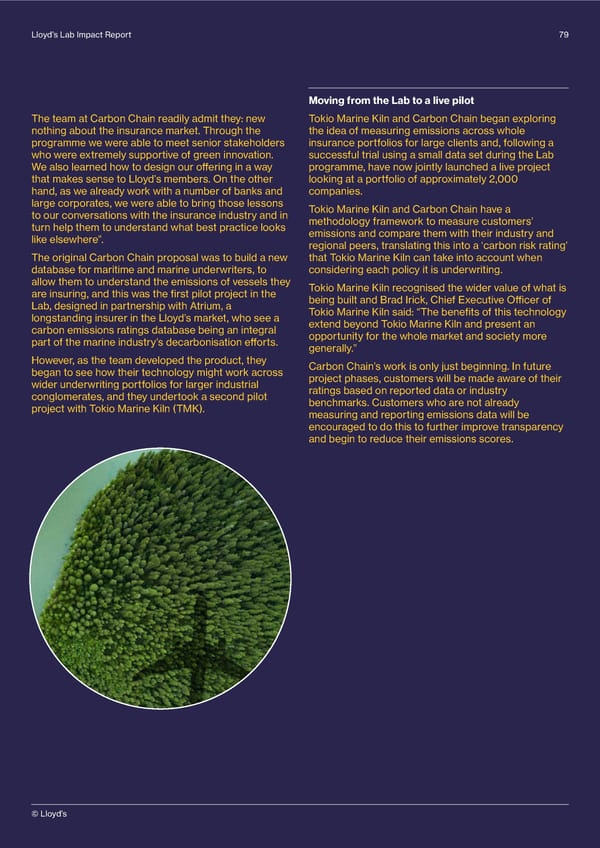78Process OptimisationLloyd’s Lab Impact Report 79 Carbon Risk Rating – greater transparency Moving from the Lab to a live pilot The team at Carbon Chain readily admit they: new Tokio Marine Kiln and Carbon Chain began exploring on the path to net zero nothing about the insurance market. Through the the idea of measuring emissions across whole Cohort 6, 2021programme we were able to meet senior stakeholders insurance portfolios for large clients and, following a who were extremely supportive of green innovation. successful trial using a small data set during the Lab We also learned how to design our o昀昀ering in a way programme, have now jointly launched a live project that makes sense to Lloyd’s members. On the other looking at a portfolio of approximately 2,000 hand, as we already work with a number of banks and companies. large corporates, we were able to bring those lessons Tokio Marine Kiln and Carbon Chain have a The journey to a successful transition into a low-carbon economy will to our conversations with the insurance industry and in methodology framework to measure customers’ turn help them to understand what best practice looks require global collaboration on a scale never seen before. Alongside the emissions and compare them with their industry and like elsewhere”. regional peers, translating this into a ‘carbon risk rating’ commitments that many nations around the world are making, Lloyd’s and The original Carbon Chain proposal was to build a new that Tokio Marine Kiln can take into account when the global (re)insurance industry have a unique role to play, providing database for maritime and marine underwriters, to considering each policy it is underwriting. allow them to understand the emissions of vessels they innovative products and services to manage and protect against a rapidly Tokio Marine Kiln recognised the wider value of what is are insuring, and this was the 昀椀rst pilot project in the being built and Brad Irick, Chief Executive O昀漀cer of changing risk landscape. Lab, designed in partnership with Atrium, a Tokio Marine Kiln said: “The bene昀椀ts of this technology longstanding insurer in the Lloyd’s market, who see a extend beyond Tokio Marine Kiln and present an This includes using market expertise to help pioneer carbon emissions ratings database being an integral opportunity for the whole market and society more new risk transfer solutions for green innovation and part of the marine industry’s decarbonisation e昀昀orts. generally.” the Lloyd’s Lab has taken a signi昀椀cant role in leading However, as the team developed the product, they the market to 昀椀nd ways to innovate in this area. Carbon Chain’s work is only just beginning. In future began to see how their technology might work across project phases, customers will be made aware of their Carbon Chain is one of a group of new start-ups that wider underwriting portfolios for larger industrial ratings based on reported data or industry have been sponsored through the Lloyd’s Lab as part conglomerates, and they undertook a second pilot benchmarks. Customers who are not already of ambitious plans for insurers to understand, measure project with Tokio Marine Kiln (TMK). measuring and reporting emissions data will be and support the transition to low-carbon transport, encouraged to do this to further improve transparency mining and industry. and begin to reduce their emissions scores. The challenge of emissions measurement The scale and pace of green innovation required means that many 昀椀rms are under pressure to demonstrate they have sustainable business operations. Critical business partners, such as banks and insurers, are now being asked to know the carbon footprints of the businesses they insure and 昀椀nance. The founders of Carbon Chain had backgrounds in mining and oil & gas. They knew that all those involved in these industries were reaching for ways to measure carbon outputs, as well as track change and Carbon Chain was set up to focus on the industrial and improvement, and they also knew that they could commodities sector (oil, gas, metals mining, agriculture, deliver these measurements. transport). hose sectors account for over half of the world’s greenhouse gas emissions. Working with commodities traders, producers, and banks that 昀椀nance commodities products, the team built out a database of emissions information on speci昀椀c commodity supply chains, plus globally signi昀椀cant, mines, smelters, re昀椀neries, cargo vessels and so on. As the database of emissions grew, Carbon Chain began to understand their data could be valuable to insurers who wished to run climate stress tests on potential clients before insuring them. © Lloyd’s
 Lloyds Lab Impact Report Page 78 Page 80
Lloyds Lab Impact Report Page 78 Page 80